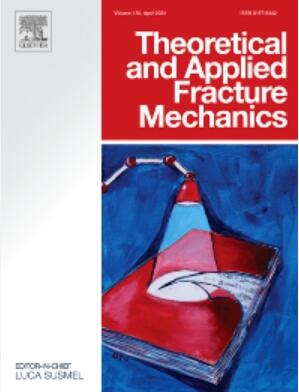A new mechanism of fracture and crack deflection around circular holes: Insights from true triaxial testing and numerical simulation
IF 5
2区 工程技术
Q1 ENGINEERING, MECHANICAL
引用次数: 0
Abstract
The mechanical properties and failure characteristics of surrounding rock in deep underground roadways differ significantly from those in shallow roadways. To investigate the fracture and crack propagation mechanisms around circular roadways, this study examines the damage characteristics and crack propagation mechanisms of rock containing circular holes under different burial depths and true triaxial stress conditions using a true triaxial testing system. The results show that circular holes exhibit a V-shaped damage pattern under different burial depths. There are three failure modes of circular holes at different burial depths: stress − dominated, hole − stress mixed, and hole − dominated. And burial depth reconfigures the damage path by regulating the hole-stress competition mechanism (burial depth coefficient Kp). Numerical simulation analysis reveals that the influence of burial depth on the damage zone follows a “promotion-inhibition-re-promotion” trend, with the turning point near the critical burial depth. For the first time, this study proposes a new mechanism of the “stress shielding effect around holes” and discovers that crack deflection around holes results from the dynamic interaction between stress redistribution and hole geometry. The proposed mechanism represents a significant breakthrough in deep rock mechanics theory and engineering practice.
地下深层巷道围岩的力学性能和破坏特征与浅层巷道有很大不同。为了研究圆形巷道周围的断裂和裂纹扩展机理,本研究使用真实三轴测试系统研究了含有圆形孔洞的岩石在不同埋深和真实三轴应力条件下的破坏特征和裂纹扩展机理。结果表明,在不同埋深条件下,圆形孔洞呈现出 V 形破坏模式。在不同埋深条件下,圆孔有三种破坏模式:应力主导型、孔-应力混合型和孔-应力主导型。而埋深通过调节孔-应力竞争机制(埋深系数 Kp)来重新配置破坏路径。数值模拟分析表明,埋深对损伤区的影响呈 "促进-抑制-再促进 "的趋势,转折点在临界埋深附近。该研究首次提出了 "孔洞周围应力屏蔽效应 "的新机制,并发现孔洞周围的裂纹偏转是应力再分布与孔洞几何形状之间动态相互作用的结果。该机制的提出是深部岩石力学理论和工程实践的重大突破。
本文章由计算机程序翻译,如有差异,请以英文原文为准。
求助全文
约1分钟内获得全文
求助全文
来源期刊

Theoretical and Applied Fracture Mechanics
工程技术-工程:机械
CiteScore
8.40
自引率
18.90%
发文量
435
审稿时长
37 days
期刊介绍:
Theoretical and Applied Fracture Mechanics'' aims & scopes have been re-designed to cover both the theoretical, applied, and numerical aspects associated with those cracking related phenomena taking place, at a micro-, meso-, and macroscopic level, in materials/components/structures of any kind.
The journal aims to cover the cracking/mechanical behaviour of materials/components/structures in those situations involving both time-independent and time-dependent system of external forces/moments (such as, for instance, quasi-static, impulsive, impact, blasting, creep, contact, and fatigue loading). Since, under the above circumstances, the mechanical behaviour of cracked materials/components/structures is also affected by the environmental conditions, the journal would consider also those theoretical/experimental research works investigating the effect of external variables such as, for instance, the effect of corrosive environments as well as of high/low-temperature.
 求助内容:
求助内容: 应助结果提醒方式:
应助结果提醒方式:


